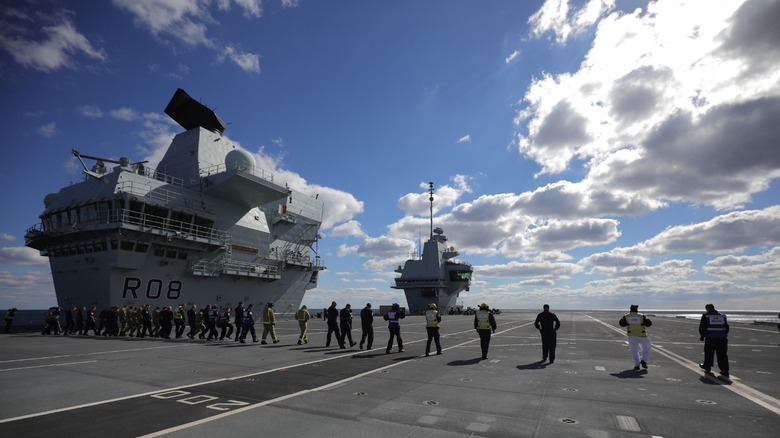Why Crew Members Have To Walk & Scan An Aircraft Carrier Before Flight Ops
The planes on board the American aircraft carriers are some of the most potent weapons available to the U.S. Navy. They're also quite expensive — for example, just one unit of the F/A-18 Super Hornet is estimated to cost around $72 million. Despite their lethality and high price, these jets (and every other aircraft around the world) are prone to damage from Foreign Object Debris or FOD.
So, to avoid this, flight deck crew members do a FOD walk before the start of flight ops. No matter what color uniform they're wearing, they line up shoulder-to-shoulder on the tiny runway, walk along its length, and scan for anything that does not belong. It could be a tiny washer that has fallen off a tow tractor, a bolt dropped from a sailor's toolbox, or maybe even a pair of hair-cutting shears that has fallen from the bag of an arriving sailor. As long as it does not belong on the flight deck, any crew member who spots it will pick it up and put it in their pocket for later disposal.
You might think that tiny items like these would not cause any problems for such mighty machines. After all, if your car can handle them, shouldn't a supersonic, missile-carrying jet be able to absorb the same amount of "minor" damage? But if you're an aircraft being accelerated down the short flight deck by a catapult to 150 mph, even the smallest things getting ingested into your engine can cause a major problem.
How much damage can FOD do to a plane?
Even something as small as a nut can damage an aircraft, and there have already been several instances of this happening around the world. In fact, one famous example of a FOD-induced crash is the Concorde, with its only fatal incident attributed to a piece of metal on the runway. If debris happens to find its way into an airplane engine while taking off, the biggest risk to the aircraft is that it will not gain enough speed to continue flying. This is less of a problem with land-based jets, as they typically have a much longer runway to stop on if they encounter an issue. They can also land at an alternative airport or even find a rather flat patch of land in case they need to get on the ground immediately due to engine damage.
However, canceling takeoff on an aircraft carrier is just plain impossible due to the catapult. Aside from that, carrier runways are just around 300 feet long, so you really won't have enough space to hit the brakes on your jet. And if you do get in the air and experience trouble, you'd be hard-pressed to find an alternate landing site, as you're likely surrounded by water.
Nevertheless, the problem isn't over should the plane make it back to the ship or if the FOD damage was discovered even before it took off. That's because maintenance teams would still need to repair the plane, costing the U.S. Navy in both materials and labor just to get it back in the air. Aside from that, aircraft are a limited resource in the middle of the sea — even the largest carriers can only carry 75 to 90 aircraft — meaning losing one could affect operations.

